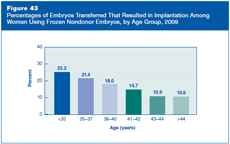Section 3: ART Cycles Using Frozen Nondonor Embryos
How does the implantation percentage for frozen nondonor embryos differ among women of different ages?
Among women using fresh nondonor eggs or embryos, the percentage of embryos transferred that resulted in implantation decreased as the age of the woman increased (see Figure 34). Figure 43 shows the same relationship between implantation percentage and the age of the woman when frozen nondonor embryos were transferred; the percentage of frozen nondonor embryos transferred that resulted in implantation decreased as the age of the woman increased (from about 25% among women younger than 35 to 11% among women older than 44).
The percentage of embryos transferred that resulted in implantation among women using frozen nondonor embryos was higher in age groups among women 38 years or older compared with the implantation percentage among women using fresh nondonor embryos (see Figure 34) in the same age groups as follows:
- 18% (frozen) vs. 17% (fresh) among women aged 38–40 years
- 15% (frozen) vs. 9% (fresh) among women aged 41–42 years
- 11% vs. 4% among women aged 43–44 years
- 11% vs. 2% among women older than age 44 years
What is the percentage of transfers that result in live births and singleton live births for ART cycles using frozen nondonor embryos?
Frozen nondonor embryos were used in approximately 18% of all ART cycles performed in 2009 (26,069 cycles). Figure 44 compares percentages of transfers that resulted in live births and singleton live births for frozen nondonor embryos with those for fresh nondonor embryos among women using their own eggs. Because some embryos do not survive the thawing process, the percentage of thawed embryos that result in live births is usually lower than the percentage of transfers that result in live births. In 2009, percentages for frozen nondonor embryos were lower than for fresh nondonor embryos, and the average number of embryos transferred was similar for cycles using frozen nondonor embryos, or lower than for those using fresh nondonor embryos depending on the woman's age. (See the national summary table for information on the average number of embryos transferred for these cycles.) It is important to note that cycles using frozen nondonor embryos are both less expensive and less invasive than those using fresh nondonor embryos because the woman does not have to go through the fertility drug stimulation and egg retrieval steps again.
What is the risk of having a multiple-fetus pregnancy or multiple-infant live birth from an ART cycle using frozen nondonor embryos?
Multiple-infant births are associated with greater problems for both mothers and infants, including higher rates of caesarean section, prematurity, low birth weight, and infant disability or death.
Part A of Figure 45 shows that among the 9,487 pregnancies that resulted from ART cycles using frozen nondonor embryos, approximately 67% were singleton pregnancies, 21% were twins, and 2% were triplets or more. Almost 10% of pregnancies ended before the number of fetuses could be accurately determined. Therefore, the percentage of pregnancies with more than one fetus might have been higher than what was reported (approximately 23%).
In 2009, 7,424 pregnancies from ART cycles that used frozen nondonor embryos resulted in live births. Part B of Figure 45 shows that approximately 23% of these live births produced more than one infant. This compares with a multiple-infant birth rate of slightly more than 3% in the general U.S. population.
Although the total rates for multiples were similar for pregnancies and live births, there were more triplet-or-more pregnancies than births. Triplet-or-more pregnancies may be reduced to twins or singletons by the time of birth. This can happen naturally (e.g., fetal death), or a woman and her doctor may decide to reduce the number of fetuses using a procedure called multifetal pregnancy reduction. CDC does not collect information on multifetal pregnancy reductions.
Read next sections:
Section 1 | Section 2A | Section 2B | Section 2C | Section 3 | Section 4 | Section 5
Contact Us:
- Centers for Disease Control and Prevention
1600 Clifton Rd
Atlanta, GA 30333 - 800-CDC-INFO
(800-232-4636)
TTY: (888) 232-6348 - New Hours of Operation
8am-8pm ET/Monday-Friday
Closed Holidays - cdcinfo@cdc.gov





